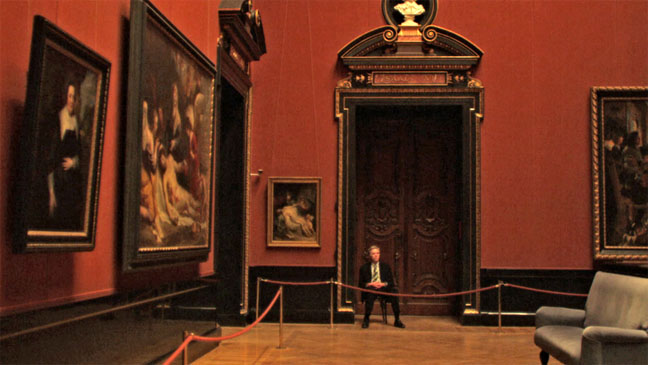 INTERIOR OF THE KUNSTHISTORISCHES MUSEUM OF VIENNA WITH BOBBY SOMMER FROM MUSEUM HOURS TRAILER Art and life in Vienna in a wonderfully unclassifiable film
INTERIOR OF THE KUNSTHISTORISCHES MUSEUM OF VIENNA WITH BOBBY SOMMER FROM MUSEUM HOURS TRAILER Art and life in Vienna in a wonderfully unclassifiable filmTall, grey haired, amiable and pensive, Vienna-born Booby Sommer could be a university lecturer. In his youth he was a promoter and manager for punk bands. In Jem Cohen's semi-documentary exploration of Vienna's Kunsthistorisches Museum, he's one of the guards, though he doesn't seem to be guarding anything. Rather he drinks in the work and ponders it and chats with visitors, sometimes at length, wandering the great rooms of the great museum, with their rich red, green, and brown walls and seemingly endless supply of old masters. Particularly so with a Canadian woman, Janet (cult singer and sometime actor Mary Margaret O’Hara), who's come to Austria to provide company for a relative long resident here who's in a hospital, comatose. The guard begins to accompany her sometimes, also on walks or visits to taverns.
Cohen meanwhile provides a rich supply of supplementary images. It's winter. What makes
Museum Hours special, because there's not a great deal happening otherwise, is the way it teaches us to see, refreshing our ability to focus on great paintings and helping us take the same eye out of doors. The difference between inside and out is enhanced by the film's two different formats. The museum views are shot in sharp, accurately colored HD. The rest were shot on Super 16, keeping softness and delicate color in the digital transfer, so they have a delicious and original faintly brush-stroked texture. And Cohen never shows you anything obvious. But besides the ideally calm, civilized, European personality of Bobby Sommer what I chiefly take away from
Museum Hours are those soft, nubbly, pastel-y winter Vienna citiscapes.
A scene of Janet singing to her comatose relative in semi darkness, with fading sunlight, is memorable and special. A handsome middle-aged woman giving a tour of the Breugels (Ela Piplits) seems to tell the usual art historical message of the panoply of peasant life and the off-center angles on great events, but when she gets to Auden's poem you realize this is no ordinary lecture. There is an extra touch of passion and wisdom.
It seems for no special reason that we see boys skateboarding out of doors. But then we cut to adolescents sitting on a bench in the museum and the guard talks about how they flaunt their boredom, but ogle the sexy canvases. He also recounts extensive discussions he had with a young man who came for a while talking of "Late Capitalism" and conspicuous consumption in the teutonic still lives, saying they were the same as if an artist drew Rolexes today.
The young man suggested the museum is irrelevant. Maybe so if the triumphs of western art mean nothing to you, but the young man kept coming back. The Kunsthistorisches Museum is a treasure trove of Breugel, Rembrandt, and Vermeer. There are also notable works by Rubens, Arcimboldo ("Summer" and "Winter"; "but 'Spring' is in Paris," the guard dryly observes), Van Eyk, Dürer, Tinturetto, and Caravaggio. But this film is not a tour, and only focuses at length on the most heavily emphasized figure, Pieter Brueghel the Elder. It's also pointed out, apropos of the Rolexes gibe, that museums are a relatively new thing and make the status symbols of the rich available to everyone, though it would be nice if both museums and movies were free.
Janet's understated observations seem idiosyncratic and original and, most of the time, unscripted.
A museum is a splendid place for unnoticed people-watching. The guard notes this but the film doesn't indulge too deeply in it because to do so would be to become too aimless and lose the sense of keen, intelligent observation that Cohen shows and awakens.
Cohen, who has a philosophy background, has been a prolific and idiosyncratic documentary fimmaker, working entirely outside the commercial mainstream for thirty years on a wild variety of topics. These include a 1987
History of New York (his place of origin and home base) full of street scenes,
Real Birds (from last year) a portrait of Brooklyn through people, objects and birds. Among the SFIFF 56 POV Award recipient’s other honors are a John Simon Guggenheim Fellowship and an Independent Spirit Award. In 2005, the Herb Alpert Foundation awarded Cohen with its Alpert Award in the Arts, stating that he “mines the forces, wonders, damages and poetry of everyday life.”
Museum Hours is one of his most elaborate, dialogue-scripted works. Indeed it could have been a bit less elaborate. As I am not alone in observing (
Hollywood Reporter's Stephen Dalton says so), it would play better if lightened by 15 or 20 minutes.
Museum Hours, 107 mins., debuted at Locarno August 2012 and has shown at other festivals. It will be shown 28 April 2013 along with Cohen's receipt of the POV ("Persistence of Vision") award at the San Francisco International Film Festival and was screened as part of that festival for this review.





